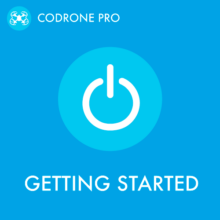
The CoDrone Pro is a small quadcopter that you need to program with Arduino, a text-based programming language, in order for it to fly! Learn about the CoDrone's…

Your remote is basically the brains of the operation. After you upload your code, it communicates with your CoDrone to tell it how exactly to fly. One thing:…

Your CoDrone Pro remote has many many features, all of which will help you fly your CoDrone. Learn about all of them in this lesson!

CoDrone Pro uses Arduino, which is a text-based programming language and environment. You need to install it on your computer (no tablets or phones for now) if you…

You should have downloaded Arduino and the CoDrone library in the last lesson, Installing Software. If not, go do that now! You still need to do a few…

Your remote control communicates with your CoDrone so it flies using your code, but you need to get that code onto the remote first! This lesson will teach…

Your CoDrone Pro will be on the latest version when you receive it, but if you happen to have an older unit, you can use this lesson to…

Air vehicles like your CoDrone move a little differently than land vehicles. While land vehicles can move forward, backward, and sometimes side-to-side, air vehicles can do all of…

Like any technology, it's easy for your CoDrone to stop working. Learn how to keep it happy and healthy in this lesson!



We've been talking about upload mode in a bunch of the previous lessons. In this lesson, you will finally be able to upload a program to your CoDrone…

Computers understand a different language than you do, so in this lesson, you're going to learn how computers communicate. You're also going to be using the CoDrone library…

Usually, you want a remote to always pair with the same CoDrone, but there might be times when you will want to program your remote to pair with…

You finally get to fly your drone! In this lesson, you'll learn how to program it so it can take off, stay in the air, and then land.…

Your CoDrone can do way more than just take off and land. In this lesson, you'll learn how to program your CoDrone to move forward and backward, right…

You might know what variables are in math or science, but what do they do in programming? This lesson will answer that question and show you how to…

Your remote control's Smart Inventor Board has three onboard infrared, or IR, sensors that you can program to help your CoDrone fly. In this lesson, you're going to…

In the last lesson, If Statements and Digital IR Sensors, you learned what if statements are and how they work. You also used them to program one of…

Besides the motors, your CoDrone has been pretty quiet. You can change that with the buzzers on the remote control's Smart Inventor Board! In this lesson, learn how…

Up until now, you've been using autonomous programs for your CoDrone. In this lesson, you finally get to use the remote control! One catch: that remote control needs…

You're going to be using a lot of flags in your programs from now on, and we're not talking about the kind that are for countries! Flags are…

Up until now, you've kind of been able to keep track of time in your program with delays, but that is not the most accurate way to do…

You probably saw that your CoDrone has LEDs that light up when it's on, but did you know you can customize them? Learn how to change your CoDrone…

In addition to the LEDs on your CoDrone, you have another set of LEDs on your remote control! Learn how to program them in this lesson.

You learned how to use functions waaaaaaay back when you started using your CoDrone. In this lesson, you will learn how to write your own functions to help…

There might be times when you need to do the same thing over and over and over again in your program. Instead of writing the same lines over…

For loops are a lot like while loops --- you can use them to repeat lines of code. However, for loops repeat those lines of code for a…

You remember variables, right? They store data that can be used later on in your program. One problem: they can only hold one piece of data. In this…

You learned about functions in previous lessons --- they're sets of code that can be named and reused in a program to perform specific tasks. Return functions do…